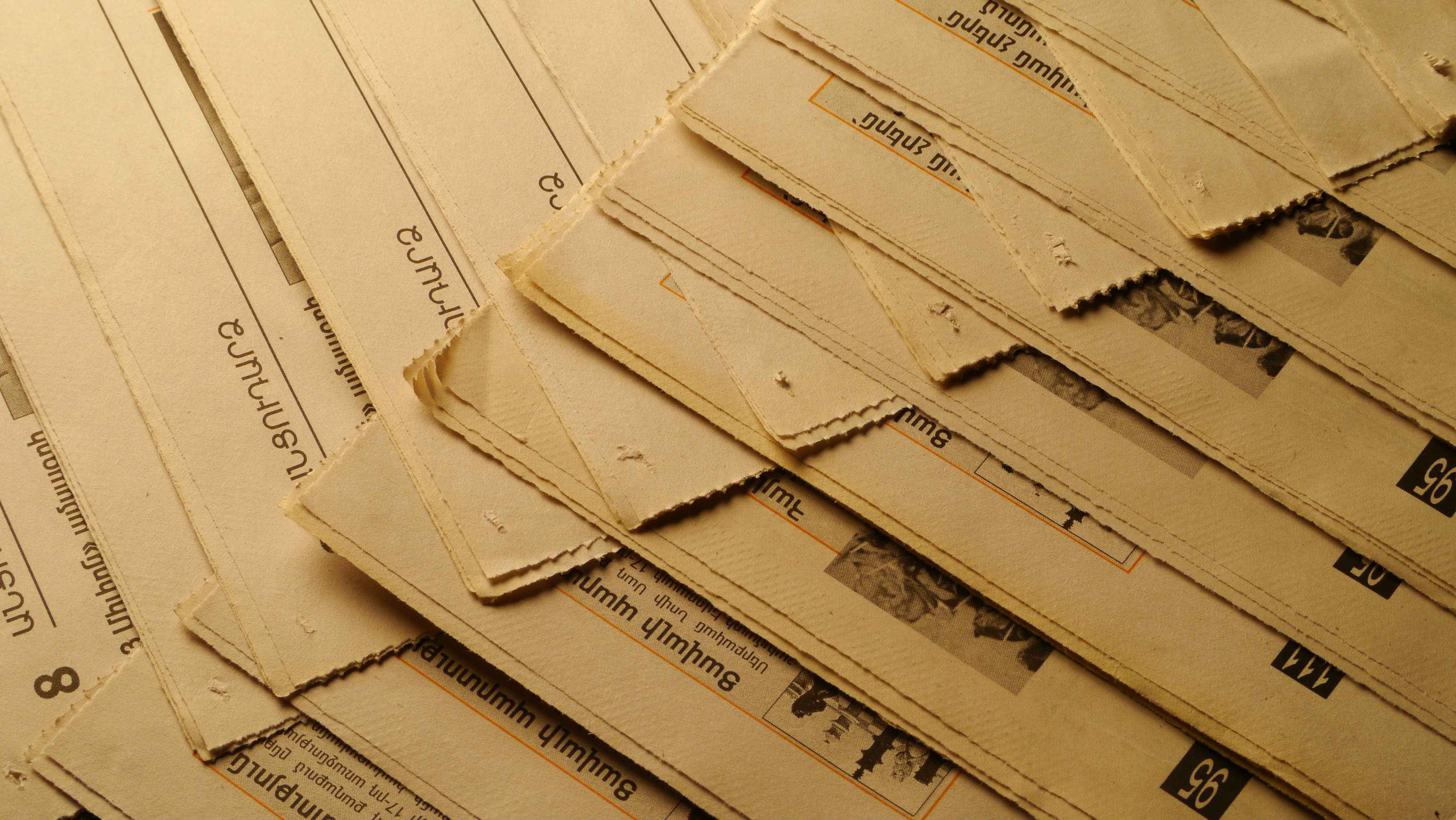
Media.am continues its interviews with chief editors of local Armenian newspapers on the problems and survival prospects of the print media in Armenia. At the end of the series, the overall trends will be summarized.
Our interviewee is 168 Zham newspaper chief editor Satik Seyranyan.
“We will be around as long as the printed book”
168 Zham triweekly
Published since September 2004.
Circulation: 5000
Printing: black and white, 8 or 16 pages
Price: 150 AMD (about $0.30)
Revenue sources: advertising, sales, subscription, and supporters.
Online version: since 2006 (replicated newspaper content); since 2013, updated online.
If we exclude the internet as the main culprit, what other factors weakened newspapers in Armenia? Government pressure, for example?
There have been, yes. The years when I worked as a journalist, there was very harsh pressure. Today, the press is much more free — there’s no comparison. Of course, there are also individual harsh manifestations [of pressure], but they’re not widespread. By the way, we often see journalists who intentionally provoke, in order to exacerbate the situation.
You can ask the same thing to someone in a normal tone, and he will reply willingly. And you can ask it in such a tone that he becomes angry.
Today, numerous inexplicable websites appear, especially from election to election, which, however, address narrow personal, “clan” issues — you can’t call them news outlets. They don’t even have editorial staff, or an address, but they sully the industry and display a certain, to put it mildly, not good attitude toward a journalist’s work.
There’s a lot of this rubbish on the internet: in this information “noise,” the ordinary person finds it difficult to filter, to distinguish specially “dumped” (mis)information from pure information. But all this can’t, as you say, weaken print media. Print media is a costly pleasure for both readers and its creators.

In the late 90s, when you were fired from the position of PR manager at an Italian company, you were told, we’re sorry, your [country’s] ruling authorities compelled us. It was because of your “Castles” series in Aravot newspaper, I remember. Doesn’t getting “punished” like this once become a sort of constraint in the future?
None whatsoever. We photographed the luxury mansions of numerous officials, getting threats on one hand, and the impatience of those anticipating the story of the next mansion on the other hand. At the time, few would dare to do such a series and start with the Armenian National Security Service chief’s castle… Now the number of castles has increased, and an immunity surrounding them has been created…
Moreover, now they acquire “castles” abroad. But the series ran then and wrapped up. Now all of us write about some official’s property and assets, cases of squandering [state] budget resources, businesses, affiliated people’s businesses, offshore accounts, unlawful activities… but to no avail. Journalists raise the issue, then the relevant law enforcement bodies have to take action, which isn’t being done.
Are there fewer readers, reduced circulation?
There are a few reasons for the drop in newspaper circulation, and this tendency began years ago in the rest of the world: first, the existence of the internet; second, the issues connected to the newspaper reaching consumers; and third, people have socioeconomic problems, problems of securing their daily bread, in order to allow themselves to buy a newspaper a few times a wee.
Newspaper printing is not a job that depends on one link. Printing and other costs increase from time to time. There was a time when we ourselves would acquire the printing paper, but the road to Lars closed, and we had problems importing paper and were forced to switch printers.
There are often problems tied to distribution; for example, when it snows heavily in Armenia, our issues don’t reach, say, Syunik marz on time, and are fully returned to us. And they wait for the newspapers especially in the marzer [regions]: very often people even want old issues, to read.

Aren’t there mechanisms for distribution companies to encourage newspaper sales?
Newspaper sales aren’t the main source of revenue in the activities of some companies, for you to motivate them to sell more. If you’ve noticed, in newsstands, for a long time now, more space is allocated to the sale of cigarettes and other items than newspapers.
Something else that’s interesting: an existing practice for years — a great many issues of the paper are returned worn-out. That is, they are read, passed through several hands. Some newsstands can sell a 150-dram newspaper for 50 dram, on the condition of having it returned. The 50 drams stays with the kiosk vendor. And the newspaper is read but ultimately, is returned to us. We can’t do anything.
Why do you call your funders “supporters” and not “sponsors”?
Because “sponsor” here [in Armenia] is perceived as someone who dictates orders. But our primary principle is to present the views of all sides as much as possible and obligatorily.
I don’t want to say that there haven’t been political offers, but since we’ve understood that that would suppress our principles, we refused.
We also have colleagues with whom we do different, not political projects, and they support us.
Even if it’s not a political request, don’t sponsors inadvertently do harm in some way? Don’t they weaken the efforts that the newspaper was to exert to attract readers? Let’s put it this way: if you solve your son’s math problems for him every day, he won’t learn math.
It’s not like that. We’re always trying to understand who our readers are, so we can print a newspaper that corresponds to their demands. After all, the initial client is the reader.
A few years ago, we commissioned a survey. Our readers are people of average age, primarily highly educated and employed. Including business managers and employees of major financial companies.
Many of our readers call 168 Zham a “newspaper you can take home” because they can read analysis or some new person’s opinion, to discover new people: authoritative experts, intellectuals (pieces by Arax Martirosyan, Gayane Khachatryan, Nvard Manvelyan, Ophelia Hovhannisyan, and others).
For years we also presented social pieces — human stories. We’re the first who began a series of stories on low-income families. We got a huge response — from both Armenia and abroad.
No foundation solved the problem as much as this series of ours. And people trusted host of the series Lusine Stepanyan. Psychologically, producing such stories takes a toll, but Lusine was able to find that strength to do it because the results were obvious.

Is it any news outlet’s function to solve problems?
If you present the problem accurately, from all sides, and consistently, the relevant authorities immediately respond. What’s wrong with that, if as a result of a news story, a person receives the free medication afforded to him by law? And you compel the respective actors who’ve become negligent in their duties to work. Ordinary people too, reading these stories, helped people who were strangers to them.
In an interview, you had stressed the importance of the role of journalists’ individuality. Can you save print media like this?
For me, it’s a very important issue. When I began the newspaper, I first invited my senior colleagues to work. First, it’s quite right when different generations work together. And second, for me it’s very easy to work with individual personalities — in all senses. Some are still here; others left, moved on to other work. There have been difficult times, during which I’ve consulted with them. They’re my friends.
But let’s not search for individual personalities only in the older generation. See, our economic analyst and editor of the economic section of168.am Babken Tunyan has begun “In 168 Hours” and today he is invited to be an expert on other platforms. Without the newspaper’s deputy editor-in-chief and the website’s editor, analyst Garnik Gevorgyan, it would be very hard for me. My sister, journalist Lilit Seyranyan, is doing enormous work; unfortunately, she no longer has time to do journalism work. Our journalists really are individual personalities.
It’s another thing all together, that it’s hard to find young individual personalities in the faculties of journalism and philology.
But numerous universities are preparing so many journalists.
Yes, I myself have been teaching at the YSU [Yerevan State University] Faculty of Journalism for many years: they get to their fourth year, then few of them want to be journalists. Former education and science minister Spartak Seyranyan described this phenomenon very well during the program “R-Evolutsia” [“R-Evolution”]: “Armenians are the only ones in the world who pay not to learn.”
Let’s get back to the problems of the newspaper. You said that 168’s online version sustains the newspaper, since the paper’s cost price has always been higher than its [sale] price. So isn’t it better to relinquish the print version?
Let me put it this way: the newspaper and the website cooperate at best. Apart from the fact that newspaper is dear to me, there’s also the need for a print newspaper. There are readers. Moreover, there are advertisers who are interested in the print version itself. There are those who want to place their ads on both platforms, since they too realize that the readers are different. Besides, people subconsciously trust the printed word.
How long will your newspaper last?
As long as there will be books, so too will there be print media. As long as 168 Zham has readers, it will always be printed.
At the end of our conversation, we were joined by the newspaper’s deputy editor-in-chief, 168.am’s editor Garnik Gevorgyan, who opined that newspapers in Armenia will gradually begin to close in 2017. That is to say, “during the parliamentary elections, print media, in any case, running on inertia will continue its work, but after the elections, the internet will become dominant.”
Interview by Ruzanna Khachatrian

Add new comment
Comments by Media.am readers become public after moderation. We urge our readers not to leave anonymous comments. It’s always nice to know with whom one is speaking.
We do not publish comments that contain profanities, non-normative lexicon, personal attacks or threats. We do not publish comments that spread hate.